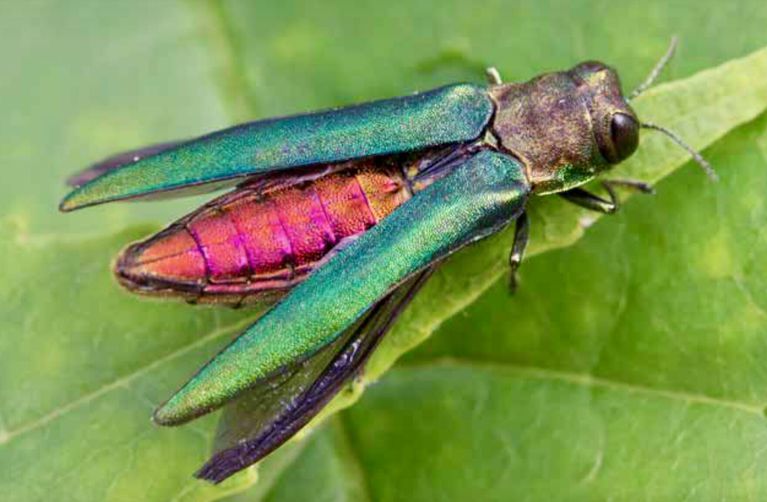
Courtesy of Oregon Department Of Forestry
I know many TSW-ites are from the Northwest so here goes:
Destructive forest pest, the emerald ash borer, arrives in Oregon; public asked to report sightings
FOREST GROVE, Ore – On June 30, Dominic Maze, an invasive species biologist for the City of Portland, was waiting outside a summer camp in Forest Grove to pick up his children when he noticed several ash trees in decline.
When he took a closer look, he recognized the distinctive D-shaped holes made by adult emerald ash borers, an invasive and destructive pest, as they exit an infested tree.
“When my kids arrived, I asked them to look for adult beetles,” said Maze. “My son promptly found one crawling on him. Knowing how many millions of ash trees across the country these beetles have killed, I felt like I was going to throw up.”
Maze’s discovery of EAB in a parking lot in Forest Grove is the first known sighting on the West Coast. Maze was familiar with EAB and signs of it in ash trees through educational materials federal and state agencies have been providing to Portland and other Oregon cities. He immediately called the Oregon Department of Forestry’s Forest Health Unit to report the EAB sighting.
ODF Forest Entomologist Christine Buhl drove to the site that same day and identified an adult EAB, known for their metallic, shiny green color. She then alerted the Oregon Department of Agriculture. Her identification was verified later by two additional invasive species specialists – Max Ragozzino with ODA and Wyatt Williams with ODF.
State officials are asking the public to learn what an emerald ash borer looks like and to report any sightings online at the Oregon Invasive Species Council hotline. This will help the state know how far and how fast this destructive insect is spreading in Oregon.
EAB is native to eastern Asia and has spread to about three dozen states since its first detection in Michigan two decades ago. EAB is now considered the most destructive forest pest in North America. Although harmless to people, pets, and animals, it has proven deadly to all ash species in North American and Europe, including the native Oregon ash (Fraxinus latifolia). EAB can also infest American fringe trees (Chionanthus virginicus) and European olive trees.
The infested ash trees in Forest Grove were cut down and chipped within 48 hours of discovery. ODF and ODA are now working closely with industry partners, including urban foresters and nursery producers, to provide information and resources as Oregon launches a response to the discovery of EAB.
Faith Campbell has an extensive blog posts on the pre-work that has been done, and is continuing, on EAB in Oregon here.
Here are some photos from her post.


Oy vey — that’s all we need. The native Oregon ash on the west coast and any exotics will be in danger.
This is the saddest thing EVER. The trapping results near the site in Oregon indicate population levels that show it has probably been at that site for at least 3-5 years…..Oregon ash does well in wetlands and poorly drained soils – there aren’t many tree species that can take its place…
I saw one Gold Beach 2 weeks ago.
I’m familiar with a number of “ash swamps” in western Oregon — a favored carving material by local Indians — but have never worked with them. According to Google, they — along with bigleaf maple, cottonwood, willow and other local deciduous trees, are capable of epicormic sprouting. Can’t the trees that have been cut and chipped, be nurtured back to a former condition from sprouts once the bugs are under control?